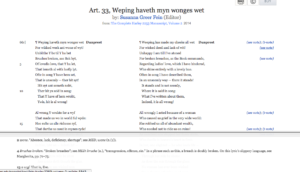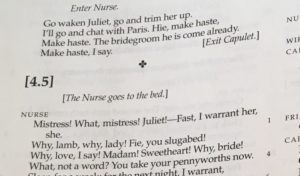My posting for this week chiefly concerns Michael Cordner’s two articles, which raise major questions about the responsibility of a play-editor, particularly an editor of Shakespeare. I want to address, primarily, the practical implications of his discussion about performance-responsive scholarly editions. While creating a performance-responsive edition is a worthy goal, I think more conversation about what such an edition might look like, and how one might go about creating it, is necessary. I don’t know if fully bridging the gap between page and stage is possible or how it might best be done—but, nevertheless, I think it must be attempted. And in the attempt, as I point out toward the end of the post, we may discover that scholarly editors and theatrical ones have more in common than may at first appear. Given the apparent animosity between the two groups (evidence of which we find in Cordner’s anecdotes and in Stephen Unwin’s introduction to King Lear), finding such common ground will be essential to creating responsible scholarly editions that benefit both scholar and actor.
I agree with the major premise of Cordner’s two articles, that responsible play-editing necessarily involves recourse to performance and theatrical interpretation. In my own research, I have found that the most helpful annotations on a given page are often those on the performance history or the performance possibilities of a particular line or passage—almost always they are the most intriguing, even inspiring, notes on the text. Along with Cordner, I would like to see more of this in standard scholarly editions. I also wholeheartedly agree with Cordner’s points about transparency: regarding annotation, emendation, punctuation, and probably a whole range of other editorial activities, the reader (at least the scholarly reader) should know as far as possible what an editor is doing and how and why he or she is doing it.
But one potential shortcoming of Cordner’s articles is that they do not really suggest practical remedies for the problems that he points out. In fact, the articles don’t claim to deal with such issues. In “Actors, Editors, and Annotation,” Cordner writes
I will not attempt to draw up comprehensive guidelines for a more performance-responsive style of annotation. It seems to me that the immediate need is simpler – i.e. to establish clearly that serious problems in this respect do repeatedly arise in Shakespearian annotation as it is currently practised. (183)
Cordner, I think, does accomplish this goal: the articles clearly establish the “serious problems” in Shakespearian annotation at the time he was writing, in 2002 and 2003. The question now is what is currently being done, or what should be done, to address the issues he raises?
Implementing practical solutions to these problems is more difficult, I think, than it may at first appear, particularly in regard to creating a “more performance-responsive style of annotation.” The major issue in creating such an annotation would be determining what, exactly, to annotate. An editor could conceivably write performance-responsive commentary for every line of text that has ever been performed by a major company. So, what are the criteria for deciding which portions of the text to annotate with information about the performance of that line or passage? An editor of any kind of text will have to deal with questions about what to annotate and what to leave alone, but bringing performance into the question seems to make the issue even more fraught.
Additionally, while I agree that editors should not necessarily privilege their own interpretations at the expense of others in their annotations, I wonder how an editor should determine exactly which other interpretations to foreground. There’s no way to address every possible performance interpretation, or even every interpretation that has appeared on a major stage. I do appreciate notes that explain common or unusual ways of performing a passage of text. But the question is where an editor should draw the line on these notes. Cordner does begin to address this question:
Annotation cannot, of course, track all the possible, plausible, performance extrapolations which have been, and could be, made from Shakespearian scripts; but, in offering explanatory help which many readers may well find indispensable in negotiating the texts’ complexities, editors need to avoid prematurely delimiting that rich field of potentiality. (187)
I agree that an editor should not “prematurely delimit” the possibilities. But a text, even a scholarly one, can only bear the weight of so many annotations, and those annotations can only take up so much space. (Unless, I suppose, you’re working on a variorum, which is another issue.) Cordner’s examples from both articles illustrate just how far an editor might go in commenting on the potential interpretations of a passage—some of his commentary on particular passages of text stretches to a page or even two, far too long for a single annotation.
I would add that an editor is valuable to a reader in part because of his or her expertise. We rely on Shakespearian editors to provide us with what they see as the best, or most accurate, or most relevant or important information about critical and stage traditions that are almost inexhaustible. Cordner criticizes editors like Rene Weis and Philip Edwards for annotations that present what is basically the editor’s subjective opinion about a certain line of text, qualifying it only with the words “probably” or “likely.” Cordner thinks these words indicate only a surface-level concession to the possibility of other interpretations. But they might equally be considered as a necessarily economical invitation to attentive readers to question the editor’s interpretation. While I think the editors should ideally provide more in the way of other interpretations, the limited space for annotations may make such additions impossible, or at least complicated. I also do appreciate, from time to time, a subjective editorial opinion. After all, we ask certain people to edit certain texts because they have a high level of expertise—the question is how much of their expert opinion they should include and how they might best go about qualifying that opinion or placing it in context.
Near the end of Cordner’s other essay, on scripts and performances in Shakespearian comedy, he encourages editors to provide more “alternative opinions” in their annotation, asking, “Do readers not deserve to be more fully briefed?” Yes, of course. But practical considerations—concerning space, particularly—may limit how briefed they can be, as I have already noted. I would also ask, “Which readers?” Cordner seems to be talking about actors and about scholars. Both of these groups have something to learn from the other and should be mutually informing. Both are also looking for different things when they come to the edited text. One of my major questions is whether one edition can handle the weight that Cordner wants to put on it without becoming overburdened, difficult to use, or in some way inaccessible. We already have editions of Shakespeare that concentrate on performance—the Shakespeare in Production series, for example, primarily details the stage history of the plays—and one might argue that there is no need to highlight such considerations in other major scholarly editions. Cordner would argue that performance is integral to interpreting Shakespearian texts, and scholarly editions that do not prioritize performance are necessarily limited. I agree—but how can we put all this information into one text?
The New Oxford Shakespeare: Modern Critical Edition begins to suggest a solution. It includes standard scholarly notes at the bottom of the page and additional performance notes in the margins. Though the pages can become cluttered, all the information is there. The performance notes and the textual notes are full, but are clearly delineated and visually separated on the page. I wonder what Cordner might think of this solution, since he insists that one cannot separate textual interpretation from performance interpretation. I also wonder how we could, in a digital edition of Shakespeare, address some of the problems that Cordner points out. Certainly a digital edition, with the capability to link to video and audio clips, has the potential to make performance much more accessible and immediate to its users—this seems to me one of the distinct advantages of the digital edition. It also presents an opportunity to link to performance content and commentary for more information on a certain passage: an editor could craft a quick note and refer readers to a fuller explanation elsewhere. The digital is making it much easier to foreground performance in the Shakespeare edition. We just have to determine the best ways to do it.
Though I have questions about the best ways to practically implement the changes Cordner suggests, I think he is right that our current scholarly editions do not do enough to encourage collaboration with actors and other theatre professionals. We have read Cordner’s account of actors’ dissatisfaction with the ways Shakespearian editors handle the text: Derek Jacobi, in particular, “asserts the authority of his hard-won experience as an actor against his academic critics’ inclination to assume that only their own mode of expertise has authority in this field” (“Scripts and Performances” 167). Jacobi’s feud with the editors happened two decades before Cordner was writing, but more recently, Stephen Unwin’s fascinating (and, one might say, aggressive) introduction to his performance edition of King Lear, written around the same time as Cordner’s two articles, shows us that the conflict between scholars and theatre professionals continues. Unwin writes that his aim was to produce an edition that is “clear, straightforward and immediate,” in contrast, one can only suppose, to unclear, unnecessarily complex, and outmoded scholarly editions of the play. He calls such editions “intimidating” and even “counterproductive” citing the Oxford Shakespeare, with its two editions of King Lear, as an example. (Though one might wonder what exactly it means to be “counterproductive” in this context.) He thinks that “Shakespeare scholars may hate” his more straightforward edition, but he highlights its effectiveness as a script in its defense (23). Unwin’s closing words are even more confrontational:
We should discover Shakespeare’s dramatic demands from his words, and not from what modern editors think. Shakespeare was an actor himself and his plays were written to be heard and on the stage. It is time for the people who stage these plays today to reclaim his extraordinary texts as their own. (24)
What an terrible impression theatre professionals must have of Shakespeare scholars—I suppose if Cordner is right, however, their resentment of editors is not wholly undeserved. That actors and directors feel they must “reclaim” Shakespearian texts from the editors, as if they were being jealously hoarded, does not speak well for our handling of them. Even if our texts are edited primarily for scholarly use, shouldn’t theatre professionals be able to glean something from them without feeling as if they must “reclaim” them for the stage? Though I’m not sure we can, or even should, keep the texts from being “intimidating,” we would do well to think more deeply about their performance, their intended medium, when crafting editorial commentary and apparatus.
Perhaps a good first step is to follow Cordner’s suggestions by being more transparent, and probably more humble, about our editorial interventions. Unwin seems to object to the same editorial hubris that Cordner points out, one that annotates as if it were handing down a play’s single, unquestionable interpretation from the Shakespeare gods. This is, of course, an exaggeration, but it is nevertheless a trap that editors may fall into. Such editors may not be entirely to blame—as I have already suggested, practical considerations may limit the types of editorial interventions they can make and the extent to which editors may incorporate other voices and other commentary. But making an attempt to collaborate more fully with our counterparts in the theatre seems well worth the effort for both of us, as Cordner argues, and easier than ever in the digital age, as I have noted.
We may also observe that our scholarly editorial activities are not, in fact, so very different from those required by theatre adapters and directors. They involve many of the same types of interventions, and both are concerned with modernization of some kind. We can see evidence of this in some of the discussion in Peter’s book chapter on theatre editions and in the film script for Justin Kurzel’s Macbeth, but Unwin’s preface to King Lear is the most explicit about its editorial process. Unwin writes that one of his first editorial acts was to identify (and cut) anything “incomprehensible”; the academic editor must also identify and explain those passages. Additionally, Unwin has undertaken to emend the play’s punctuation, a task scholarly editors also perform (though not very satisfactorily, if we are to trust Cordner’s opinion). Furthermore, theatre professionals, like scholarly editors, must decide, when the early texts offer alternatives, which actor speaks which line—as in the final scene of Lear, for example. And all of the ways in which adapters, directors, and actors cut, add, rearrange, and otherwise emend Shakespeare’s text involve, in some cases even constitute, acts of interpretation, as does their ultimate performance of that text. Interpretation is, of course, a foundational practice, maybe the foundational practice, of both actors and scholars. Perhaps we may begin to bridge the gap by acknowledging the many similarities between how we, as scholars, handle Shakespeare’s words and how theatre professionals handle them.
At the end of his essay on scripts and performances in Shakespearian comedy, Cordner suggests a concrete way to form productive relationships with Shakespearian actors:
In the rehearsal room pragmatic day-by-day reality demonstrates the susceptibility of words upon the page to different – even sometimes radically opposed – vocalizations. Only by conceding this, and acting wholeheartedly upon its implications, can an open-minded, mutually profitable dialogue with ambitious and intelligent actors such as Jacobibe made possible. (182)
Perhaps this is the pitch we should make to Shakespearian editors: create performance-responsive editions; talk to celebrities. If becoming a good editor of Shakespeare allows me to engage in “open-minded, mutually profitable dialogue” with Benedict Cumberbatch (or Patrick Stewart, or Helen Mirren, or Michael Fassbender, or…), then count me in.



 scene beginnings is interesting in conjunction with the way Bevington formats scene beginnings in the main body of the text. Although Bevington’s edition has text in each of the three lines of print dividing scene four from scene 5, the scene number is in a large font, making these three lines take up space equivalent to sic regular lines of the play. Accordingly, these three lines of print leave substantial negative space between scenes, accentuating the division between them. The small clover-shaped flourish at the end of scene four and the bold typeface for the scene number heighten this division. However, both the scene numbers and stage directions are offset with square brackets, which at once make it explicit that these additions are editorial interventions and perhaps also add a visual sense of uncertainty–although these are the traditional scene divisions, they’re tentatively put forward as the result of editorial tradition rather than words from Shakespeare’s pen. Like the location notes, the formatting of the scene change is at once designed to provide a clear division between the scenes, and to show that these subdivisions of the text and editorial interventions may not have been available to a contemporary reader of the play.
scene beginnings is interesting in conjunction with the way Bevington formats scene beginnings in the main body of the text. Although Bevington’s edition has text in each of the three lines of print dividing scene four from scene 5, the scene number is in a large font, making these three lines take up space equivalent to sic regular lines of the play. Accordingly, these three lines of print leave substantial negative space between scenes, accentuating the division between them. The small clover-shaped flourish at the end of scene four and the bold typeface for the scene number heighten this division. However, both the scene numbers and stage directions are offset with square brackets, which at once make it explicit that these additions are editorial interventions and perhaps also add a visual sense of uncertainty–although these are the traditional scene divisions, they’re tentatively put forward as the result of editorial tradition rather than words from Shakespeare’s pen. Like the location notes, the formatting of the scene change is at once designed to provide a clear division between the scenes, and to show that these subdivisions of the text and editorial interventions may not have been available to a contemporary reader of the play.